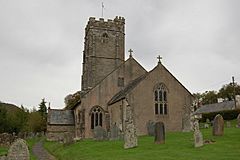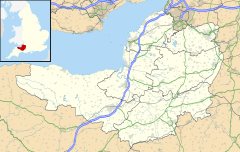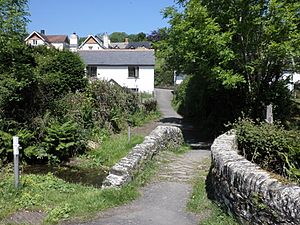Winsford, Somerset facts for kids
Quick facts for kids Winsford |
|
|---|---|
 Winsford church |
|
| Population | 321 (2011) |
| OS grid reference | SS905345 |
| District |
|
| Shire county | |
| Region | |
| Country | England |
| Sovereign state | United Kingdom |
| Post town | Minehead |
| Postcode district | TA24 |
| Dialling code | 01643 |
| Police | Avon and Somerset |
| Fire | Devon and Somerset |
| Ambulance | South Western |
| EU Parliament | South West England |
| UK Parliament |
|
Winsford is a small village in Somerset, England. It's about 5 miles (8 km) north-west of Dulverton. This village is inside the beautiful Exmoor National Park. It's also about 10 miles (16 km) south-west of the coastal town of Minehead.
Winsford has a historic hotel called The Royal Oak, which is over 500 years old! There's also a small shop. You can find Winsford along the Samaritans Way South West walking path. East of the village is a tiny settlement called West Howetown.
Contents
Winsford's Past: A Look at History
Winsford has a long and interesting history. On Winsford Hill, you can find the Wambarrows. These are ancient burial sites from the Bronze Age, a time when people used bronze tools.
There's also Road Castle, an Iron Age fort. It's about 2 miles (3.2 km) west of the village. This fort has a square-shaped bank and ditch. It covers an area of about 0.7 acres (0.28 hectares).
The Caratacus Stone: An Ancient Mystery
The area is home to the Caratacus Stone. This is a standing stone that people believe was put up by early villagers. It might have been a religious memorial. The stone has an old inscription that says CARAACI NEPUS. This means "kinsman of Caratacus". It might be from the 5th century. People first wrote about this stone in 1219.
Winsford in the Domesday Book
Winsford is even mentioned in the Domesday Book from 1085. This was a big survey of England ordered by King William the Conqueror. The book shows that Winsford had 34 small farmers and 41 villagers. There were also 52 sheep and 9 enslaved people. The area could support 64 ploughs, even with 40 acres (16 hectares) of woodland.
Old Farms and Famous Outlaws
Many farms in Winsford still have their original names. These include Nethercote, Staddon, Bradley, Halse, Upcott, and Knaplock. These names were first recorded in tax records from 1327. This was during the time of King Edward III of England.
In the 1600s, a famous highwayman named Tom Faggus was known in the area. He was said to have stopped travelers near the inn in Winsford.
Sheep and Community Spirit
Winsford played a role in sheep farming history. On August 20, 1907, the first official sale of Exmoor Horn sheep happened here. The Exmoor Horn Sheep Breeders' Society was founded a year earlier. About 1,200 ewes were sold at this event.
In 1998, a charity took over the old Winsford First School building. They created the Exmoor Community Computer Centre. This place became a community hub for social activities and learning. It helps people in the area use computers and connect.
How Winsford is Run: Local Government
Winsford has a parish council. This group handles local issues for the village. They decide on a local tax to cover their costs. They also check local building plans.
The parish council works with the police and local groups on safety and traffic. They also help keep parish facilities in good shape. They talk with the district council about roads, paths, and public transport. Looking after local trees and the environment is also their job.
District and County Councils
Winsford is part of the Somerset West and Taunton district. This council handles things like planning permission and building rules. They also manage local roads, housing, and waste collection. Parks, tourism, and markets are also their responsibility.
Somerset County Council manages bigger services. These include education, social services, and libraries. They also look after main roads, public transport, and the police and fire services.
Representing Winsford in Parliament
The village is part of the Tiverton and Minehead constituency. This means people in Winsford vote for one Member of Parliament (MP). This MP represents them in the British House of Commons in London.
Winsford's Natural Surroundings: Geography
The name Winsford comes from the "ford" or crossing point over the Winn Brook. This is where the brook meets the River Exe. There are eight bridges in the village. They help people cross the many small streams. One of these is a very old packhorse bridge, which is hundreds of years old.
The Punchbowl: A Unique Landscape
Winsford Common is in a dip in the countryside. It looks a bit like a "punch bowl," which is how it got its nickname, The Punchbowl. This deep hollow might have been the site of a small glacier during the Pleistocene ice age. It was also a meeting spot for local hunting groups.
The ground in Winsford has a rock layer called shillet underneath. The top layer of soil is more like clay and loam. Iron ore can be found in the village's mineral deposits. Mining iron was once important for Winsford's economy. Garratts Wood is a small forest covering about 1.11 hectares (2.74 acres). The Woodland Trust owns and manages it.
Winsford's Church: St Mary Magdalene
The village church is called St Mary Magdalene. It was partly fixed up in 1858. The church tower is 90 feet (27 meters) high and was built in three parts. It has six bells. The four heaviest bells were made by Thomas Bilbie in 1765.
Inside the church, there is a beautiful painted panel from 1609. This was during the time of King James I of England. The ironwork on the inner doors might be from the 13th century. It may have come from a nearby priory called Barlynch Priory. The font is from the Norman period. The organ was put in around 1900. The church's records go back to 1660. This church is a Grade I listed building, meaning it's very important historically.
Notable People from Winsford
Winsford has been home to some interesting people.
Ernest Bevin: A Political Leader
In 1881, Ernest Bevin was born in the village. He became an important politician for the Labour Party (UK) in the UK. He even held a high government position called Lord Privy Seal.
Charles Samuel Myers: A Pioneer in Psychology
In 1946, a leading English psychologist named Charles Samuel Myers passed away at his home in Winsford Glebe. He was famous for his work in the study of the mind and behavior.



